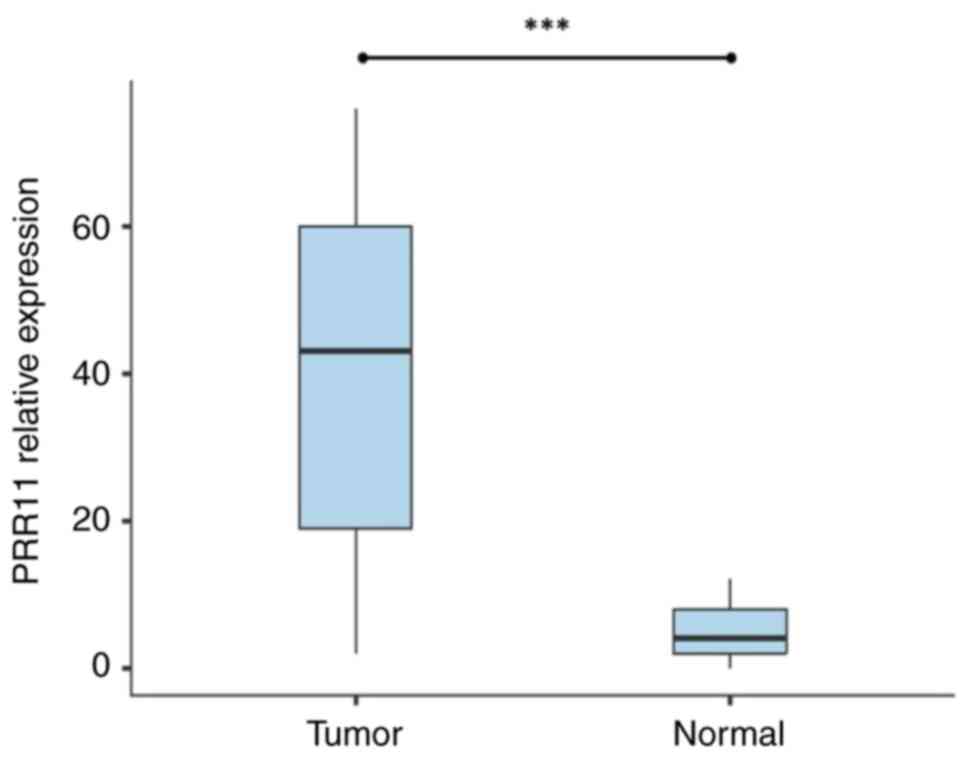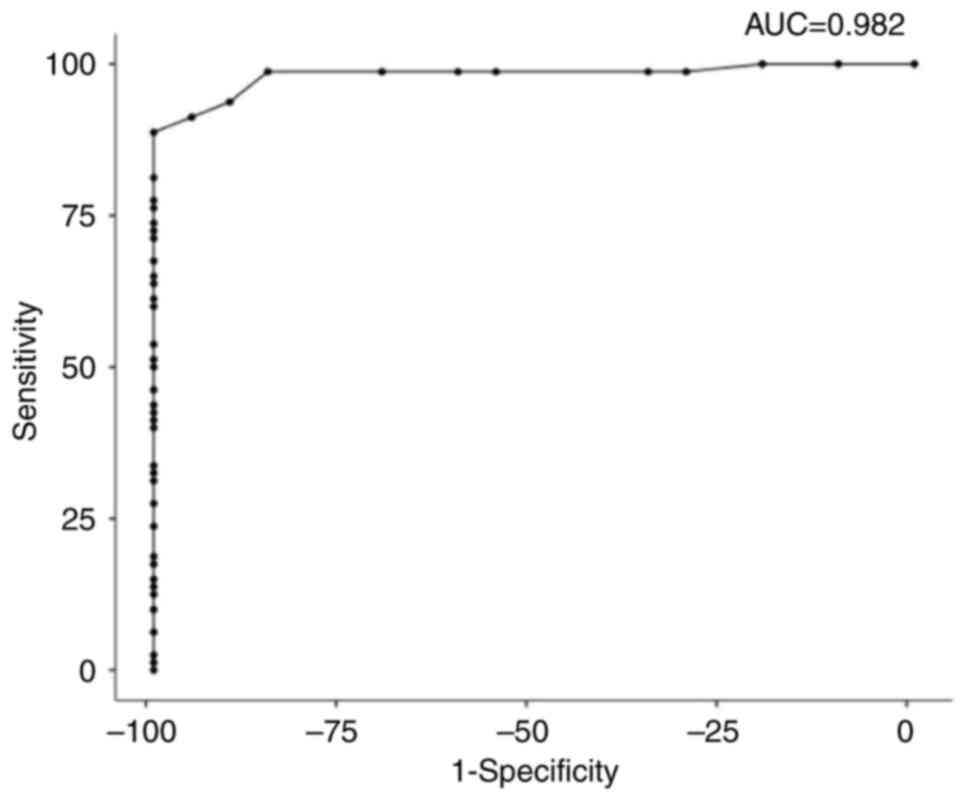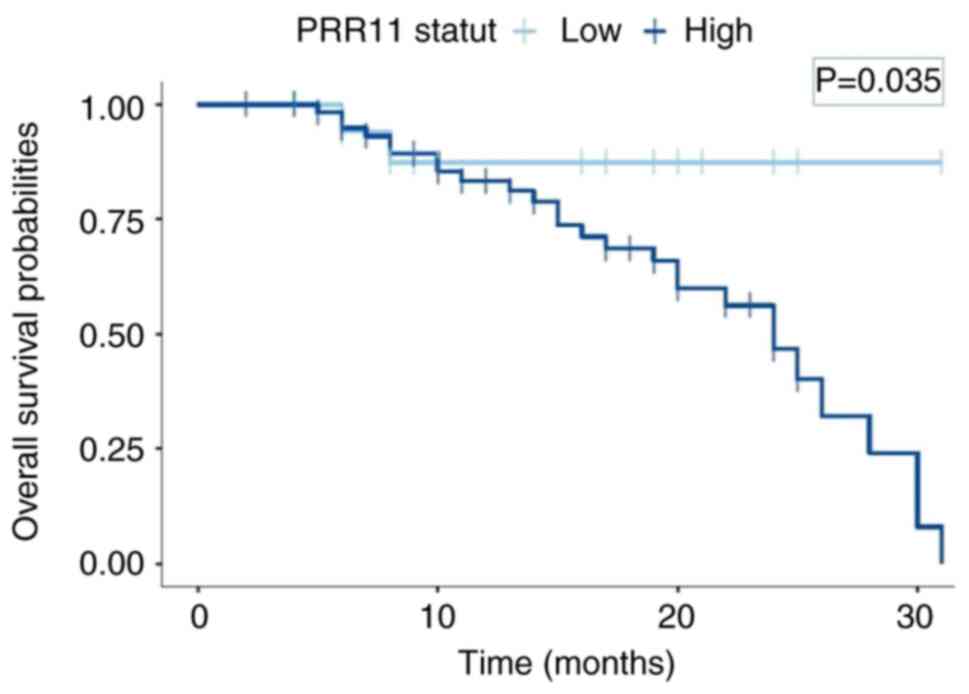|
1
|
Sung H, Ferlay J, Siegel RL, Laversanne M,
Soerjomataram I, Jemal A and Bray F: Global cancer statistics 2020:
GLOBOCAN estimates of incidence and mortality worldwide for 36
cancers in 185 countries. CA Cancer J Clin. 71:209–249.
2021.PubMed/NCBI View Article : Google Scholar
|
|
2
|
Bruni L, Serrano B, Roura E, Alemany L,
Cowan M, Herrero R, Poljak M, Murillo R, Broutet N, Riley LM and de
Sanjose S: Cervical cancer screening programmes and age-specific
coverage estimates for 202 countries and territories worldwide: A
review and synthetic analysis. Lancet Glob Health. 10:e1115–e1127.
2022.PubMed/NCBI View Article : Google Scholar
|
|
3
|
Ai Q, Bu YQ, Liu Z, Lan H, Ji Y, Du G,
Yang ZM, Liu GL and Song FZ: Structural and functional analysis of
human PRR11 promoter. Chin J Biochem Mol Biol. 27:356–363. 2011.(In
Chinese).
|
|
4
|
Chen Y, Cha Z, Fang W, Qian B, Yu W, Li W,
Yu G and Gao Y: The prognostic potential and oncogenic effects of
PRR11 expression in hilar cholangiocarcinoma. Oncotarget.
6:20419–20433. 2015.PubMed/NCBI View Article : Google Scholar
|
|
5
|
Ji Y, Xie M, Lan H, Zhang Y, Long Y, Weng
H, Li D, Cai W, Zhu H, Niu Y, et al: PRR11 is a novel gene
implicated in cell cycle progression and lung cancer. Int J Biochem
Cell Biol. 45:645–656. 2013.PubMed/NCBI View Article : Google Scholar
|
|
6
|
Wang Y, Zhang Y, Zhang C, Weng H, Li Y,
Cai W, Xie M, Long Y, Ai Q, Liu Z, et al: The gene pair PRR11 and
SKA2 shares a NF-Y-regulated bidirectional promoter and contributes
to lung cancer development. Biochim Biophys Acta. 1849:1133–1144.
2015.PubMed/NCBI View Article : Google Scholar
|
|
7
|
Tan S, Jiang Z, Hou A, Wang J, Zhang J and
Dai L: Expression of PRR11 protein and its correlation with
pancreatic cancer and effect on survival. Oncol Lett. 13:4117–4122.
2017.PubMed/NCBI View Article : Google Scholar
|
|
8
|
Li K, Yu H, Zhao C, Li J, Tan R and Chen
L: Down-regulation of PRR11 affects the proliferation, migration
and invasion of osteosarcoma by inhibiting the Wnt/β-catenin
pathway. J Cancer. 12:6656–6664. 2021.PubMed/NCBI View Article : Google Scholar
|
|
9
|
Hu H, Song Z, Yao Q, Geng X, Jiang L, Guo
C and Li H: Proline-rich protein 11 regulates self-renewal and
tumorigenicity of gastric cancer stem cells. Cell Physiol Biochem.
47:1721–1728. 2018.PubMed/NCBI View Article : Google Scholar
|
|
10
|
Zhou F, Liu H, Zhang X, Shen Y, Zheng D,
Zhang A, Lai Y and Li H: Proline-rich protein 11 regulates
epithelial-to-mesenchymal transition to promote breast cancer cell
invasion. Int J Clin Exp Pathol. 7:8692–8699. 2014.PubMed/NCBI
|
|
11
|
Anouar Tadlaoui K, Alaoui Sosse S,
Benhessou M, El Karroumi M and Ennaji MM: Proline-Rich Protein 11
Overexpression in Invasive Breast Carcinoma: A Potential Diagnosis
Biomarker. Indian J Gynecol Oncolog. 21(35)2023.
|
|
12
|
Zheng W, Zhu G, Huang Y, Hua J, Yang S,
Zhuang J, Wang J, Huang Q, Xu J and Ye J: PRR11 promotes growth and
progress of colorectal cancer via epithelial-mesenchymal
transition. Int J Clin Exp Med. 10:13109–13122. 2017.
|
|
13
|
Zhu J, Hu H, Wang J, Yang Y and Yi P:
PRR11 overexpression facilitates ovarian carcinoma cell
proliferation, migration, and invasion through activation of the
PI3K/AKT/β-catenin pathway. Cell Physiol Biochem. 49:696–705.
2018.PubMed/NCBI View Article : Google Scholar
|
|
14
|
Zhao Z, Pang Z, Xu L, Chen Y and Yang Y:
Expression of PRR11 and SKA2 in cervical cancer tissues and its
relationship with prognosis. Chin J Cancer Prev Control.
12:206–211. 2020.
|
|
15
|
Agha R, Abdall-Razak A, Crossley E, Dowlut
N, Iosifidis C and Mathew G: STROCSS Group. STROCSS 2019 Guideline:
Strengthening the reporting of cohort studies in surgery. Int J
Surg. 72:156–165. 2019.PubMed/NCBI View Article : Google Scholar
|
|
16
|
Livak KJ and Schmittgen TD: Analysis of
relative gene expression data using real-time quantitative PCR and
the 2(-Delta Delta C(T)) method. Methods. 25:402–408.
2001.PubMed/NCBI View Article : Google Scholar
|
|
17
|
Lee EY and Muller WJ: Oncogenes and tumor
suppressor genes. Cold Spring Harb Perspect Biol.
2(a003236)2010.PubMed/NCBI View Article : Google Scholar
|
|
18
|
Wang C, Yu L, Ren X, Wu T, Chen X, Huang Y
and Cheng B: The oncogenic potential of PRR11 gene in tongue
squamous cell carcinoma cells. J Cancer. 10:2541–2551.
2019.PubMed/NCBI View Article : Google Scholar
|
|
19
|
Zhang L, Lei Y, Zhang Y, Li Y, Bu Y, Song
F and Zhang C: Silencing of PRR11 suppresses cell proliferation and
induces autophagy in NSCLC cells. Genes Dis. 5:158–166.
2017.PubMed/NCBI View Article : Google Scholar
|
|
20
|
Tadlaoui KA and Ennaji MM: The molecular
mechanism of novel oncogenes dysregulating signaling pathways
associated with cervical carcinoma. Immunological Implications and
Molecular Diagnostics of Genitourinary Cancer. 19–31. 2023.
|
|
21
|
Xu M and Chang L: The Expression of PRR11
in Cervical Cancer and Its Effect on the Proliferation and
Apoptosis of Cervical Cancer Cell. Labeling Immunoassays and
Clinical Medicine. 27:349–355. 2020.DOI:
10.11748/bjmy.issn.1006-1703.2020.02.035.
|
|
22
|
Qiao W, Wang H, Zhang X and Luo K:
Proline-rich protein 11 silencing inhibits hepatocellular carcinoma
growth and epithelial-mesenchymal transition through β-catenin
signaling. Gene. 681:7–14. 2019.PubMed/NCBI View Article : Google Scholar
|
|
23
|
Song Z, Liu W, Xiao Y, Zhang M, Luo Y,
Yuan W, Xu Y, Yu G and Hu Y: PRR11 is a prognostic marker and
potential oncogene in patients with gastric cancer. PLoS One.
10(e0128943)2015.PubMed/NCBI View Article : Google Scholar
|
|
24
|
Wang C, Yu L, Hu F, Wang J, Chen X, Tai S
and Cheng B: Upregulation of proline rich 11 is an independent
unfavorable prognostic factor for survival of tongue squamous cell
carcinoma patients. Oncol Lett. 14:4527–4534. 2017.PubMed/NCBI View Article : Google Scholar
|













